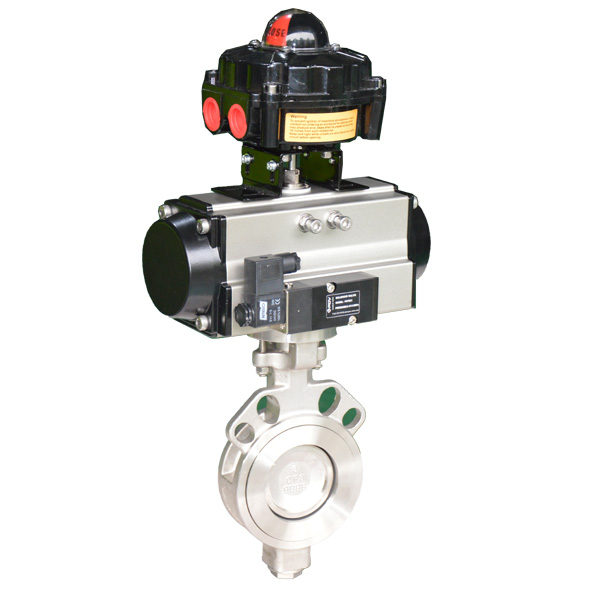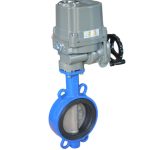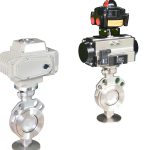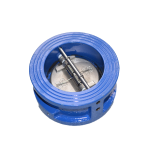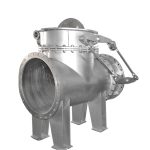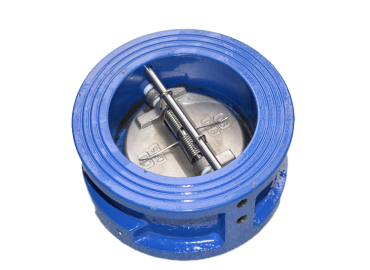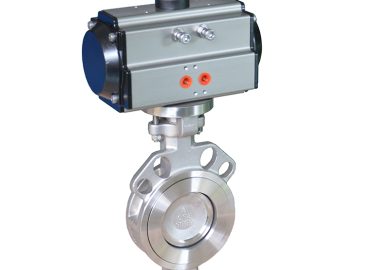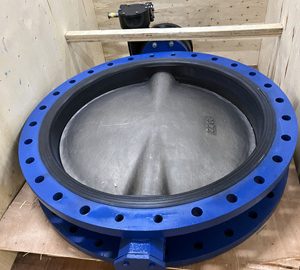In the realm of fluid control systems, gate valves and butterfly valves play crucial roles. These two types of valves, while similar in their primary function – controlling the flow of liquid or gas – differ significantly in their design, operation, and applications. A gate valve uses a ‘gate’ or a wedge to regulate fluid flow, whereas a butterfly valve employs a rotating disc for the same purpose. These differences in structure influence their performance, cost-effectiveness, ease of installation and maintenance, and suitability for different applications. Understanding these distinctions is essential in choosing the right valve for a specific task.
Introduction
Gate valves and butterfly valves are critical components in fluid control systems, each with its unique design and operational characteristics. Gate valves operate by using a “gate” or a wedge that moves up and down to allow or prevent fluid flow. Their bodies feature a straight-through design, which minimizes the chances of fluid leakage. On the other hand, butterfly valves use a rotating disc, also known as a flap valve, to control fluid flow. The disc is fixed on a metal rod, which requires only 90 degrees of rotation to transition between fully open and fully closed positions. This makes butterfly valves more efficient in terms of operation and space usage. Butterfly valves are generally lighter and more compact than gate valves, making them easier to install, especially in pipes with larger widths. Despite these differences, both gate valves and butterfly valves serve the primary function of starting, stopping, and regulating the flow of water or other fluids in a system. Therefore, the choice between a gate valve and a butterfly valve would depend on the specific requirements of the system, such as the type of fluid, flow rate, pressure, and temperature conditions.
Brief explanation of what valves are and their importance in controlling flow in a system.
Valves are mechanical devices that control the flow and pressure of liquids, gases, and bulk materials within a system. They serve a vital function in numerous industrial applications, from plumbing systems to oil refineries. The primary purpose of a valve is to regulate, direct, or control the flow of a fluid by opening, closing, or partially obstructing various passageways. This means they can start, stop, or reduce the flow of the fluid when needed. By doing so, valves help maintain a safe operating environment, protect equipment from damage, and ensure the efficient operation of a system. Without valves, controlling the flow of fluid through a system would be nearly impossible, leading to potential overflows, leaks, and even catastrophic system failures.
Introduction to the two types of valves being discussed – gate valve and butterfly valve.
In the world of fluid dynamics and control systems, gate valves and butterfly valves are two prominent types of valves utilized extensively across various industries. Gate valves, as their name suggests, function much like a gate. They use a flat or wedge-shaped component that moves vertically to allow or block the flow of fluid. This type of valve is known for its ability to provide robust shut-off capabilities, making it ideal for applications that require tight sealing and infrequent operation. On the other hand, butterfly valves operate using a disc mounted on a rotating shaft. When the disc is turned parallel to the flow, it allows fluid to pass through, and when it’s turned perpendicular to the flow, it blocks the passage. Known for their compact design and quick operation, butterfly valves are particularly useful in systems that require regular flow regulation. Despite their distinct designs and operational principles, both gate valves and butterfly valves play vital roles in controlling the flow of fluids within a system.

What is a Gate Valve?
A gate valve, also known as a sluice valve, is a type of valve that uses a gate or wedge to control the flow of fluid. This gate moves up and down along threaded stems, either manually or by electric motors, to allow or prevent fluid flow. The design of a gate valve features a straight path for the fluid, which means there is minimal pressure drop when the valve is in the fully open position. One of the key characteristics of gate valves is their ability to cut through liquids; this makes them particularly suitable for viscous fluids. Gate valves are typically used in applications where a straight-line flow of fluid and minimum flow restriction are needed. They are excellent for on-off services and are often used in systems that require infrequent use. However, they are not recommended for throttling purposes as the high flow velocity can cause erosion of the disc and seats when the valve is partially opened. It’s important to note that gate valves can take longer to open and close because the gate must be screwed up and down the stem, but this slow operation also helps prevent water hammer effects.
Detailed description of gate valves.
A gate valve, also known as a sluice valve, is a type of control valve that regulates the flow of a fluid by lifting a barrier or ‘gate’ out of the fluid’s path. It operates through a multi-turn mechanism, which means that the operation of the valve is carried out via a threaded stem. The valve needs to be turned multiple times to transition between the open and closed states. The core components of a gate valve include a valve body, seat and disc, a spindle, gland, and a wheel for operating the valve. The seat and the gate together perform the function of stopping or allowing the flow. Gate valves can be either non-rising or rising stem types; the latter enables users to determine the valve’s status at a glance. They are most commonly used in water supply systems due to their ability to completely stop or allow the flow of water, making them an ideal choice for isolation purposes. Special types of gate valves, such as knife gate valves, are designed to control the movement of slurries and viscous liquids.
Structure and working principle of gate valves.
A gate valve, often referred to as a sluice valve, is a type of valve that controls the flow of fluid by lifting a barrier or gate out of the fluid’s path. The operational mechanism of a gate valve is straightforward – the stem, which is connected to the gate, is rotated by turning a handwheel. This rotation moves the gate up or down via the threads, allowing for the unobstructed flow of fluid when fully opened, or halting the flow when closed. The movement of the gate is linear, occurring in conjunction with the valve stem. Some gate valves feature a solid wedge gate, which is a common structure in operational gate valves. When fully opened, gate valves do not obstruct the path of the fluid, resulting in very little pressure loss. However, one disadvantage is that they cannot regulate or throttle the flow. It’s important to note that gate valves are considered multiturn valves, meaning their operation involves multiple rotations of the stem.
Typical applications of gate valves.
A gate valve is a widely used control valve that either permits the unobstructed flow of media or halts it completely. The typical applications of gate valves are numerous and varied, spanning several industries. In the oil and gas industry, pharmaceuticals, manufacturing, automotive, and marine sectors, gate valves are a common sight. They are also frequently found in water supply systems due to their ability to effectively control the movement of fluid. Additionally, gate valves are ideal for applications involving slurries as the gate can cut right through. They are designed for fully open or fully closed service and are often installed in pipelines as isolating valves. It’s crucial to remember that gate valves should not be used for regulating flow; this is more commonly done with a globe valve. When fully open, a typical gate valve has no obstruction in the flow path, resulting in minimal pressure loss.

What is a Butterfly Valve?
A butterfly valve is a type of quarter-turn rotational motion valve that is used to regulate, stop, and start fluid flow in a system. The name ‘butterfly’ comes from the disc in the center of the valve, which is mounted on a rotating shaft. When the valve is closed, the disc is turned to completely block off the passageway, and when the valve is fully open, the disc is rotated a quarter turn to allow unrestricted flow. The disc’s position can be adjusted to control the flow of fluid, making the butterfly valve a form of flow control valve.
The structure of a butterfly valve is simple yet effective. It typically consists of only a few main components: the body, the disc, the stem, and the seat. The body provides a path for the fluid and supports the other components; the disc controls the fluid flow; the stem connects the disc to an actuator or manual lever; and the seat provides a sealing surface for the disc when the valve is closed.
Butterfly valves are known for their durability, reliability, and cost-effectiveness. They have a compact design that requires less space than other types of valves, making them ideal for use in systems where space is limited. They also require less material to manufacture, resulting in lower costs.
Butterfly valves are versatile and can be used in a wide variety of applications. They are commonly found in water distribution systems, chemical services, and food processing industries due to their ability to handle large flow rates and a wide range of temperatures and pressures. They are also used in HVAC systems for controlling the flow of cooling water and in fire protection systems due to their quick shut-off capabilities.
Despite their many advantages, butterfly valves also have some limitations. For instance, they may not provide a complete seal when closed, leading to potential leakage. They are also not recommended for use with thick liquids or slurries, as the disc can become clogged. However, these limitations can often be mitigated by selecting the appropriate type and size of butterfly valve for the specific application.
Detailed description of butterfly valves.
A butterfly valve is a type of valve that isolates or regulates the flow of a fluid by using a rotating disc or disk-shaped seating element. It is categorized as a quarter-turn valve, indicating that the valve’s operation involves a 90° turn of the stem and disc from the open to closed position or vice versa. This design confers several advantages, such as quick actuation, lightweight construction, and a small installation footprint. The basic configuration of a butterfly valve includes a stem connected to a disc, which is rotated to control fluid flow. Butterfly valves are widely used in different applications, including pipelines for water supply due to their ability to efficiently shut-off flow. They can be employed to start, stop, and even regulate (throttle) the flow of fluids within large pipe diameters. However, it’s important to note that while butterfly valves are versatile, their suitability depends on the specific application and operating conditions.
Structure and working principle of butterfly valves.
A butterfly valve is composed of a few key components: the body, the disc, the stem, and the seat. The body provides a path for fluid and supports the other components. The disc, which is centrally mounted on a rotating stem, is the crucial part that regulates fluid flow. The stem, which can be controlled manually or by an actuator, rotates the disc. The seat provides a sealing surface for the disc when the valve is closed to prevent leakage.
The working principle of a butterfly valve is fairly straightforward. In the open position, the disc is turned so that it allows fluid to pass through freely. When the valve is closed, the disc is rotated a quarter turn (90 degrees) so that it blocks the flow of fluid completely. The disc’s position can be adjusted in between these two extremes to regulate the flow of fluid, making butterfly valves suitable for throttling applications. The simplicity of this operation, along with the durability and cost-effectiveness of butterfly valves, makes them an attractive choice for a wide range of applications.
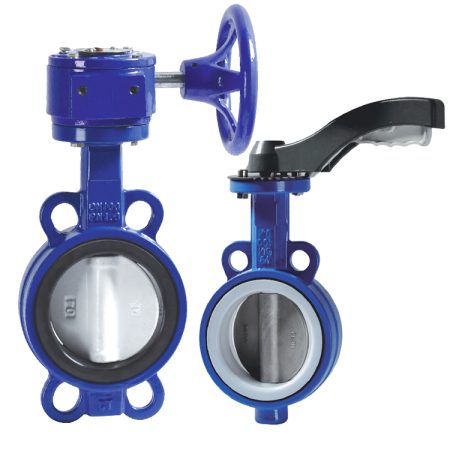
Typical applications of butterfly valves.
Butterfly valves have a wide range of applications due to their versatile nature. They are commonly used in water distribution systems, such as wastewater treatment plants, where they regulate and isolate the flow of water. In the oil and gas industry, butterfly valves are used in fuel handling systems to safely control the flow of crude oil, natural gas, and petrochemicals. In the food and beverage industry, these valves are used for sanitary purposes, helping to maintain hygiene standards while controlling the flow of liquids. Butterfly valves are also prevalent in HVAC systems, where they control the flow of cooling or heating fluids. In addition to these, butterfly valves find usage in fire protection systems, owing to their quick shut-off capabilities. Their compact design and ease of operation make them an attractive choice for many industrial processes that require effective flow control.
Key Differences between Gate Valve and Butterfly Valve
Gate valves and pneumatic butterfly valves are both commonly used in flow control systems, but they have significant differences in design, operation, and application. A gate valve operates by lifting a gate or wedge out of the path of the fluid flow, allowing for unrestricted flow when fully opened. This makes gate valves particularly suitable for applications where minimal flow resistance is required. They also provide a good shutoff capability and can be used in high pressure and temperature environments. On the other hand, a butterfly valve uses a disc that rotates to allow, block, or throttle fluid flow. Butterfly valves are quicker to operate, as they only require a quarter-turn to open or close, and are lighter and more compact than gate valves. They are ideal for applications where space and weight are considerations. However, when fully open, butterfly valves still introduce some flow resistance due to the disc’s presence in the flow path. Furthermore, gate valves are better suited for on/off services, while butterfly valves offer better throttling capabilities. In terms of cost, butterfly valves are typically less expensive than gate valves. Therefore, the choice between gate and butterfly valves will depend on the specific requirements of the application, including factors like operating pressure and temperature, required flow control, space limitations, and budget.
Comparison in terms of structure and function.
Gate valves and butterfly valves are two distinct types of valves used to control fluid flow, but they differ significantly in their structure, function, and usage.
A gate valve uses a “gate” or wedge that moves up and down to control fluid flow. This design is a multi-turn valve, which means it takes multiple turns of the stem to move the gate from the open to the closed position. Gate valves are known for their durability and longevity. They provide good sealing when fully closed, but require more space for installation and operation.
On the other hand, a butterfly valve, also referred to as a flap valve, consists of a fixed disc that revolves around the stem of the valve shaft to open and close. This design is a quarter-turn valve, meaning it only needs a 90-degree rotation to move from fully open to fully closed. Butterfly valves are known for their compact design and quick operation3. Even though they have a higher pressure tolerance, their lifespan might be shorter compared to gate valves.
In conclusion, the choice between a gate valve and a butterfly valve depends on the specific application, space availability, required durability, and cost considerations.
Comparison in terms of cost-effectiveness.
Gate valves and butterfly valves are both commonly used in fluid control systems, but they have notable differences, particularly in terms of cost-effectiveness. Butterfly valves are generally considered more cost-effective in most sizes and materials compared to gate valves. They are lighter and smaller, which simplifies installation and reduces material costs. This lightweight construction also makes them easier to use in situations involving large pipe widths. Gate valves, on the other hand, require more space for installation and operation, which can increase cost. However, it’s worth noting that for nominal diameters below DN80, gate valves are usually cheaper than butterfly valves. Regardless, the choice between a gate valve and a butterfly valve should be based not only on cost but also on the specific application and operational requirements.
Comparison in terms of ease of installation and maintenance.
Gate valves and butterfly valves differ significantly in terms of installation and maintenance. A butterfly valve’s small size and low weight make it relatively easy to install, maintain, and repair. The operation of a butterfly valve involves a simple rotating motion to adjust pressure and flow rate, which is generally easier compared to the linear motion required by gate valves. Industrial butterfly valves are considered more portable than gate valves, simplifying their installation and operation in situations involving wide pipes. When it comes to maintenance, gate valves might be more challenging due to their design and the need for precise alignment when installing the gate or wedge. Some users have expressed a preference for butterfly valves over gate valves in terms of cost, safety, and ease of installation and replacement. To summarize, while both gate and butterfly valves have their unique advantages, butterfly valves are often recognized for their ease of installation and maintenance.
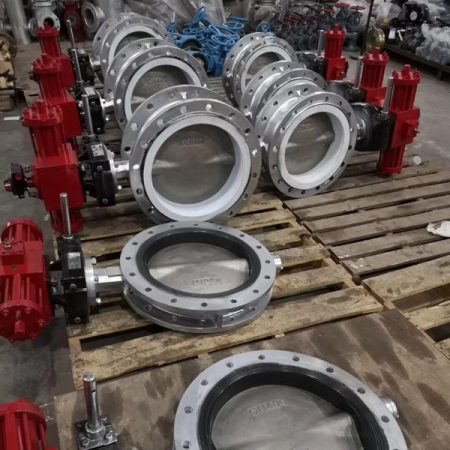
Comparison in terms of performance (flow control, pressure drop, etc.).
When comparing the performance of gate valves and butterfly valves, several key differences emerge. Gate valves are excellent for providing complete shutoff when closed due to their linear motion design. They offer superior sealing performance for substances with suspended solids and grit, making them ideal for applications that require a tight seal. However, gate valves require more space for installation and operation, which can be a disadvantage in constrained environments.
On the other hand, butterfly valves are lighter and more compact than gate valves, making them easier to install and operate, especially in situations involving large pipe widths. They provide excellent leak tightness and have the added advantage of being able to modulate fluid flow rates, giving them better control capabilities. However, they may introduce a pressure drop in the system when fully open due to the disc’s presence in the flow path. In terms of cost-effectiveness, butterfly valves are usually less expensive than gate valves, making them a more economical choice for certain applications.
Advantages and Disadvantages of Gate Valves
Gate valves, widely used in various industries for their ability to control the flow of liquids and gases, have several advantages. One of the primary benefits of gate valves is their ability to minimize flow resistance due to their straight-through, unobstructed design when fully open. This allows for minimal loss of pressure, making them suitable for applications where maintaining the flow rate is vital. Gate valves are also known for providing a reliable and tight seal when fully closed, preventing leakage. They can handle high-pressure environments and a wide range of temperatures, making them versatile for different industrial applications.
However, gate valves also have a few disadvantages. They are generally slower to operate, as they require multiple turns of the stem to open or close the valve fully, which may not be ideal for applications that require quick shutoff. Gate valves are typically more complex and heavier than other types of valves, which can make them more challenging to install and maintain. They are also more expensive compared to other valve types like butterfly or ball valves. Additionally, gate valves are not suitable for throttling purposes, as partial opening can cause vibration, noise, and damage to the valve disc and seat.
In conclusion, while gate valves offer several advantages like minimal flow resistance and robust sealing capabilities, they also have disadvantages such as slow operation, complexity, and unsuitability for throttling. The choice to use a gate valve should be based on the specific requirements of the application.
Pros of using gate valves.
Gate valves have several advantages that make them a popular choice for many applications. Firstly, they provide good sealing when fully closed, reducing the risk of leaks and making them ideal for applications where tight shut-off is required. Secondly, gate valves are durable and can last for a long time with minimal maintenance, which can lower long-term costs. Thirdly, these valves offer low flow resistance when fully open, allowing for unobstructed flow of the medium. Lastly, gate valves are versatile and can handle a wide range of pressures and temperatures, making them suitable for a variety of environments.
Cons of using gate valves.
Gate valves, while widely used in fluid control systems, have several disadvantages that may affect their suitability for certain applications. One primary disadvantage is that gate valves open and close slowly, which makes them unsuitable for rapid operations. This slow operation can also lead to water hammer effects. Another disadvantage is their propensity for high friction and erosion over time, which can damage the sealing faces and impact their performance. Gate valves can be prone to scratches, which can further degrade their efficiency. Moreover, the assembly, start-up, and maintenance of gate valves require a large space, which can be a limiting factor in certain installations. Lastly, the sealing surface of gate valves is susceptible to erosion and abrasion, making maintenance more challenging.
Advantages and Disadvantages of Butterfly Valves
Lug butterfly valves, often used in various industries like wastewater treatment, oil and gas, and food and beverage, come with several advantages. One of their key benefits is their compact design. They require less space compared to other valve types, making them ideal for applications where space is limited. This smaller size also results in a lighter weight, which simplifies the installation process and reduces material costs. Another advantage is their ability to control flow rates, allowing operators to adjust the flow of fluid more precisely. Moreover, butterfly valves are known for their excellent leak-tightness and lower maintenance requirements, which can contribute to long-term cost savings.
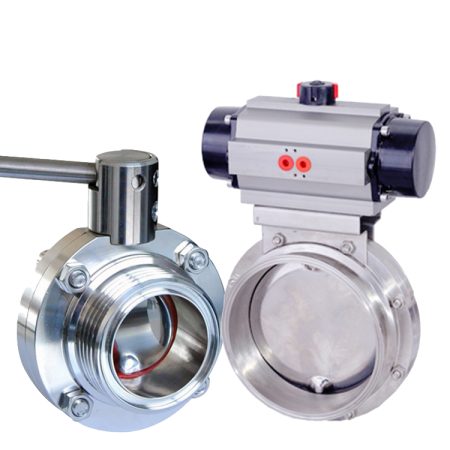
However, butterfly valves also have some disadvantages. One significant drawback is the potential for a pressure drop in the system when the valve is fully open, due to the disc’s presence in the flow path. They may not be suitable for applications involving high-pressure systems or where a complete seal is required. Another limitation is that they may not perform as well in systems transporting abrasive or corrosive fluids, as the disc and seat can be susceptible to wear and damage. Lastly, since butterfly valves are not bi-directional, they cannot be used in systems where flow needs to be controlled in both directions. Therefore, while butterfly valves offer numerous benefits, their suitability depends heavily on the specific application.
Pros of using butterfly valves.
Butterfly valves offer several advantages that make them a popular choice in various industries. Their compact design and lighter weight make them easier to install and handle, especially in large-diameter piping systems. This also results in reduced cost for support structures in an installation. Butterfly valves are known for their quick operation as they require only a quarter turn to open or close, making them ideal for applications that require fast shutoff. They also provide good throttling capabilities, allowing for precise control of fluid flow. Additionally, butterfly valves are typically less expensive than other types of valves, like gate valves, making them a more cost-effective solution.
However, butterfly valves also have some disadvantages. One notable drawback is the potential for a pressure drop in the system when the valve is fully open, due to the disc obstructing the flow path. While they provide a reasonable seal, they may not be as effective as other valve types (like gate or globe valves) in preventing leakage when fully closed. Lastly, butterfly valves may not be suitable for certain applications involving high temperatures or corrosive materials, as the disc and seat material may degrade under these conditions.
In conclusion, while butterfly valves offer several benefits such as ease of installation, quick operation, and cost-effectiveness, they also have drawbacks including potential pressure drop and limitations in sealing performance and material compatibility.
Cons of using butterfly valves.
Butterfly valves, while offering several benefits, do have certain drawbacks that may limit their suitability in some applications. One significant disadvantage is their limited control over flow rates, making them less ideal for situations where precise flow regulation is required. Another issue is the susceptibility to cavitation and choked flow, especially in high-pressure differential applications. Furthermore, a part of the disc always faces the flow even when fully opened, which can lead to increased wear and tear. This also means that butterfly valves are prone to corrosion when used with viscous or corrosive fluids, as these fluids tend to scour against the disc during operation. Lastly, despite their simple construction, butterfly valves have comparatively less pressure withstanding capability than other valve types like gate valves.
Choosing Between Gate Valve and Butterfly Valve
Choosing between gate valve and butterfly valve depends largely on the specific requirements of the application. Gate valves are well-suited for applications that require tight shut-off, as they provide excellent sealing when fully closed. They also offer low flow resistance when fully open, which can be beneficial in systems where unobstructed flow is necessary. Moreover, gate valves are durable and can handle a wide range of pressures and temperatures, making them a good choice for environments with fluctuating conditions. However, they do have several drawbacks, including slow operation speed and susceptibility to erosion and damage over time.
On the other hand, butterfly valves are compact and lightweight, making them ideal for applications where space is limited. They are also known for their excellent leak-tightness and lower maintenance requirements, which can lead to long-term cost savings. Butterfly valves can control flow rates more precisely, which is useful in processes where flow regulation is important. However, they may not be suitable for high-pressure systems or where a complete seal is required, due to the potential for a pressure drop when the valve is fully open. Additionally, they may not perform as well in systems transporting abrasive or corrosive fluids.
Ultimately, the choice between gate valves and butterfly valves should be based on the specific needs of the application, taking into account factors such as the type of fluid being controlled, the operating environment, space constraints, and budget considerations.
Factors to consider when deciding which valve to use.
When choosing between gate valve and butterfly valve, several factors should be considered to ensure optimal performance. One of the first things to consider is the nature of the fluid being controlled. For instance, butterfly valves are often more suitable for handling large volumes of water or gas, while gate valves are more effective for applications involving viscous fluids or liquids with suspended particles. The operating pressure and temperature in the system is another important factor. Gate valves can withstand higher pressures and temperatures compared to butterfly valves, making them more appropriate for high-pressure or high-temperature systems. The available space and weight limitations should also be considered. Butterfly valves are more compact and lightweight than gate valves, making them a better choice for installations with limited space or weight capacity. Furthermore, the need for flow regulation should also be taken into account. While both types of valves can regulate flow, butterfly valves offer better throttling capabilities. Lastly, cost considerations may also play a role in the decision. Generally, butterfly valves are cheaper than gate valves, but the total cost of ownership, including installation, maintenance, and operation costs, should be evaluated.
Situations where gate valves are the better choice.
Gate valves are typically the better choice in scenarios that require tight sealing and precise flow control. They are excellent for applications where leakage prevention is crucial, as they provide a tight seal when fully closed. Gate valves are also ideal for handling thick fluids or liquids with suspended solids, as they have a straight-through flow design that minimizes flow resistance. They are particularly well-suited for high-pressure and high-temperature environments, due to their robust construction. Moreover, gate valves are more resistant to wear and tear from abrasive fluids, making them a suitable choice for processes involving such substances. Lastly, if the system requires infrequent operation or remains in a static position for extended periods, a gate valve is preferable because it minimizes the risk of valve seat damage from constant operation.
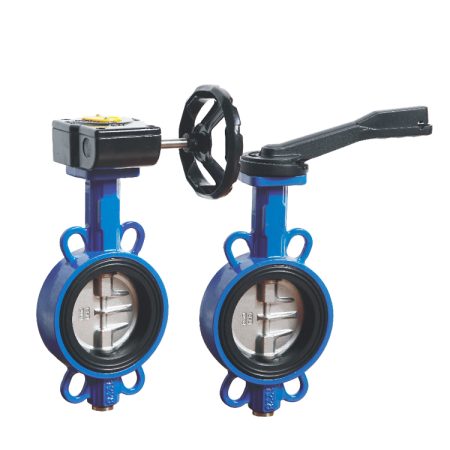
Situations where butterfly valves are the better choice.
Butterfly valves can often be the better choice in a variety of situations due to their unique advantages. For instance, they are generally more cost-effective and easier to install compared to other types of valves like gate valves. They are also appreciated for their efficiency and offer the benefit of being lightweight, which means they require less support. When it comes to high shut-off pressure situations, the use of butterfly valves should be carefully considered, potentially favoring globe valves instead. However, in water treatment plants, butterfly valves are often preferred because they provide the best seal able to withstand water pressure. Even though butterfly valves may not be suitable for processes that require precise control, such as mixing paints or food flavors, they shine in situations where controlling large flow amounts is necessary due to their minimal turbulence and pressure drop. Overall, the decision between gate valves and butterfly valves should be guided by the specific requirements of the application.
Conclusion
In conclusion, the differences between gate valves and butterfly valves are significant, and understanding these differences is crucial when deciding which valve to use in a specific application. A primary distinction lies in their design: gate valves feature a straight-through design with a “gate” or wedge that rises and falls to control fluid flow, offering excellent sealing when fully closed. On the other hand, butterfly valves, also known as flap valves, comprise a rotating disc attached to a stem, which opens and closes the valve.
Butterfly valves are generally lighter and more compact than gate valves, making them easier to install and operate, especially in situations where space is limited. They require only 90-degrees of movement to move from full-open to full-close, providing quick operation. However, they may not be ideal for high-pressure systems or where a complete seal is required due to potential pressure drop when the valve is fully open.
Gate valves, while slower in operation compared to butterfly valves, are advantageous in applications that need tight shut-off and unobstructed flow. They are durable and can handle a wide range of pressures and temperatures. However, they may not be as versatile as butterfly valves due to their larger size.
The choice between a gate valve and a butterfly valve ultimately depends on the specific needs of the application, taking into account factors such as the type of fluid being controlled, the operating environment, space constraints, and budget considerations. By understanding the key differences between these two types of valves, you can make an informed decision that best suits your requirements.
A brief recap of the differences between gate valve and butterfly valve.
Gate valve and butterfly valve serve similar purposes in controlling fluid flow, but they differ significantly in their design, operation, and best use cases. Gate valves operate by lifting a gate or wedge out of the path of the fluid, providing a straight-through, unobstructed flow when fully open. This design makes them ideal for applications requiring tight shut-off or minimal flow resistance, and they can handle high pressures and temperatures effectively. However, they are slower to operate and more prone to wear and tear.
Butterfly valves, on the other hand, control flow using a disc that rotates around a central axis. They are compact, lightweight, and quick to operate, making them suitable for applications where space is a constraint or rapid shut-off is required. They also excel in flow regulation tasks due to their throttling capabilities. However, they may not provide as tight a seal as gate valves, and they might not be the best choice for high-pressure systems or systems transporting abrasive or corrosive fluids.
In summary, while both gate and butterfly valves are essential tools in fluid control, their differences in design and operation make them better suited to different applications. The choice between the two should be guided by the specific requirements of the system in which they will be used.
Final thoughts on the importance of choosing the right type of valve for specific applications.
The importance of choosing the right type of valve for specific applications cannot be overstated. The correct valve choice directly impacts the efficiency, safety, and longevity of your entire system. Using an inappropriate valve can lead to increased maintenance costs, reduced operational efficiency, and potentially even system failure. It’s not just about selecting a valve that fits, but one that performs optimally under the given conditions. Each valve type has distinct attributes and is designed to perform best under certain conditions. Therefore, understanding the specific requirements of your system, such as flow control needs, pressure and temperature ranges, and the nature of the fluid being controlled, is critical in making the right choice. Furthermore, factors like cost, installation space, and maintenance requirements should also be considered. In conclusion, the right valve selection is a critical component of any successful fluid handling system.


